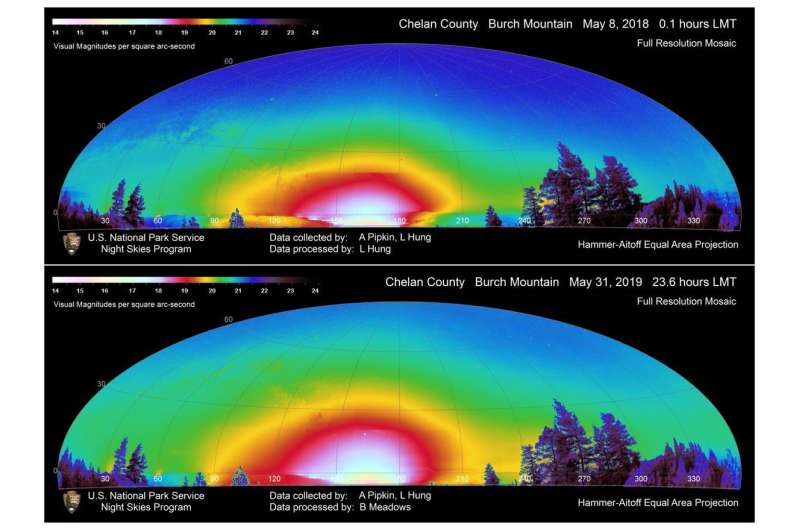After street lights in an entire county were swapped to LEDs, light pollution got worse

"The best laid plans of mice and men often go awry"—this famous paraphrase of Scottish poet Robert Burns sometimes sums up human ingenuity. That is exactly what happened when a county in Washington State decided to replace all of its county-owned streetlights with LEDs, at least partially in an effort to combat light pollution. New research shows that they actually made the light pollution worse.
Dr. Li-Wei Hung and her colleagues at the National Park Service recently released a paper currently available on arXiv that details work that they did to monitor the night sky both before and after Chelan County replaced their streetlights with LEDs.
Chelan County is located in the north-central part of the state and serves as a gateway to several outdoor recreational areas nearby, including North Cascades National Park. Given this interest in the outdoors, less light pollution would seem like a benefit to stargazing hoping to catch a glimpse of the Milky Way.
So the county decided to replace all 3,693 of the county-owned streetlights (60% of the total outdoor streetlights in Chelan County) with "full cutoff" light-emitting diodes for bulbs. About 80% of these new LEDs were 3000 K, or warm white light, while the other 20% were slightly brighter 4000 K bulbs that were installed to meet lighting requirements set by the Washington State Department of Transportation.
The retrofit process took place between 2018 and 2019, and Dr. Hung and her team took measurements both before the install and after all of the new lights were in place. What they found was surprising, to say the least. The sky actually got brighter in the county after the LEDs were installed.

Such a result is only counterintuitive because LEDs are generally thought of as being much more energy-efficient and better for light pollution. An experiment in Flagstaff, Arizona attempted to leverage LEDs to create the world's first "International Dark Sky City" in 2018, though results are still out on its effectiveness.
If the results in Chelan County are anything to go by, that experiment might not be successful. Dr. Hung and her colleagues looked at three different metrics of calculating how dark the sky is—how bright the skyglow in the county was, how high it went, and upward radiance, which measures the light directed upward.
The researchers used several tools to comprehensively calculate the differences in light pollution. First, the National Park Service has a night sky camera system, which allowed the researchers to take simple before-and-after pictures of the night sky in the Chelan County area. More data was then collected by the Visible Infrared Imaging Radiometer Suite (VIIRS), which is located on the Suomi National Polar-orbiting Partnership Satellite.
Of the three metrics measured by these instrument, the brightness and height of the skyglow increased, while the upward radiance actually decreased. The explanation the authors put forward for why, exactly, the light pollution got worse is that there was an increase in light emissions shorter than 500 nm, closer to the blue end of the visible spectrum. As for why the amount of light directed upward decreased, it was most likely due to a combination of the directionality of the LEDs as well as better shielding on the lamppost themselves.
Despite actually making light pollution slightly worse, the LED retrofit can still be considered a success for its other two goals—decreasing energy consumption and cost. The LEDs are undeniably more energy-efficient than the high-pressure sodium lamps they replaced, and will last much longer, decreasing their overall cost to the county. While the energy and cost savings are great, astronomy enthusiasts everywhere can hope that other municipal authorities that are considering similar upgrades can take into account how new LEDs might affect their night skies. Using all of the best aspects of LEDs could lead to happy humans and mice all around.
Li-Wei Hung et al, Changes in night sky brightness after a countywide LED retrofit, Journal of Environmental Management (2021). DOI: 10.1016/j.jenvman.2021.112776
No comments:
Post a Comment